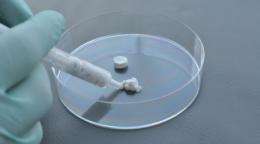Smart material can heal bone

How do get something to grow out of nothing? This is what the polymer chemistry team at the Department of Chemistry at Ångström Laboratory is discovering at great speed. Their findings mean that we soon will not have to be operated on to heal severe bone fractures or burn injuries. All we will need is an injection.
“Explore everything – stop at nothing”. This quote, which introduces Sonya Piskounova´s dissertation on smart biomaterial, is taken from Lara Croft, the heroine of the game Tomb Raider. The motto reflects the attitude of the research team in materials chemistry at Ångström Laboratory. An attitude largely based on interdisciplinary collaboration. Besides chemists, the team includes biologists, medical researchers, surgeons, and materials scientists.
Sonya herself holds a master’s degree in biotechnology. The research speciality is called regenerative medicine and is about developing new biomaterials and methods to get human bone, cartilage, nerves, and skin to heal itself.
Sonya Piskounova is concentrating on the creation of new bone tissue with the aid of a biomolecule called BMP-2, which is a protein that makes bones grow. The problem with BMP-2 is that it breaks down in the body in just a few minutes.
"What’s new, and what I show in my dissertation, is that by having a gel-like substance carry the protein, a so-called hydrogel, you can control both how and where the new bone is to grow," explains Sonya Piskounova.
This hydrogel can be injected and is moreover made from a type of sugar (hyaluronic acid). It occurs naturally in the body in humans and animals and is otherwise used in cosmetic products for treating wrinkles. This offers major advantages.
"On the one hand, you avoid open surgery and the risk of complications and infections that entails, and, on the other hand, there is no risk that the body will reject it, says Sonya Piskounova.
Applications in healthcare include both healing complicated bone fractures and growing bone tissue where there is too little or none at all. This involves defects following bone fractures and cancer or when the jawbone is too weak to support a tooth implant. Clinical testing is already underway at Karolinska University Hospital.
"The tests show that it’s working well, but the problem we need to solve is how to determine the optimal dosage of the protein. Otherwise inflammations can occur in surrounding tissue."
Despite this hitch, Sonya Piskounova is certain that this type of treatment will soon be a reality in our hospitals.
"Within ten years. I’m absolutely sure, she says, hitting the table with her fist."
















